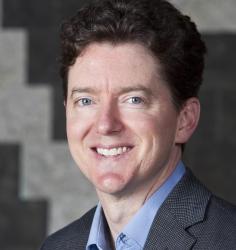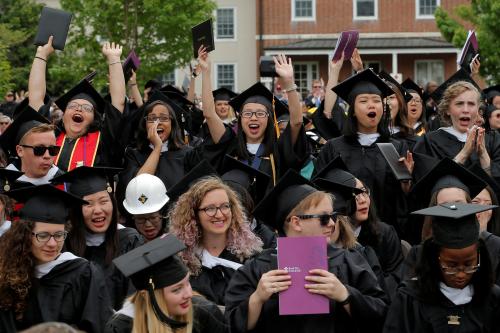The price of college is rising, making college feel out of reach for a rising share of Americans. Families can borrow to be sure, but with total student loan debt now above $1 trillion nationally, the situation seems unsustainable. Meanwhile, we face a long-term decline in our international ranking on college attainment and the disparities in college access by race and income—disparities that financial aid and loans are supposed to address—seem larger than ever. It is no surprise then that in the campaign for U.S. President in the 2016 election, nearly all candidates of both major political parties raised the issue of college affordability.
Increasing financial aid to students is one obvious potential solution. Once limited to discussions of the size of need-based aid programs such as Pell grants and state-based merit aid programs, new forms of aid have emerged. Place-based “promise scholarships” provide funds to students attending schools in certain cities and states. Others have proposed changes on a national scale, increasing and redesigning financial aid to eliminate student loan debt, called debt-free college, or going even further by eliminating tuition, fees, and/or some share of living expenses—free college.
This study examines one of the first randomized control trials of a program similar to many free college and promise scholarship proposals. The Degree Project was launched in Milwaukee Public Schools (MPS) in 2011. Students in 18 randomly selected high schools were promised up to $12,000 to pay for college, at essentially any in-state institution. These funds were sufficient to cover all tuition and fees at the local two-year college—making it a form of free or debt-free college. The funds could also be used to attend four-year colleges, covering more than one year of tuition, and fees. To receive the funds, students had to graduate on time from an MPS high school with at least a 2.5 cumulative GPA and a 90 percent class attendance rate, and fill out the Free Application for Federal Student Aid (FAFSA).
The Degree Project had some impact on students’ motivation, college expectations, and steps toward college, such as applying to more colleges and FAFSA completion. However, it had no effect on the performance measures and no effect on whether students went directly on to college. The most recent evidence does suggest that the scholarship may have slightly increased persistence and graduation in two-year colleges, though not in four-year colleges. We are continuing to track these effects; however, it seems clear at this point that many of the potential benefits, during and just after high school, did not emerge.
Through additional quantitative and qualitative evidence, we identify three related reasons why the effects were not more substantial: (a) the performance requirements greatly reduced the number of students who could plausibly receive the funds; (b) the performance requirements, combined with the temporary, small-scale design, meant that the program did not have the catalyzing effect on high schools that otherwise similar programs have seen; and (c) the context in Milwaukee—particularly, the very low level of academic performance and lack of counselor resources— may have been particularly ill-suited to make a performance-based aid program work well.
In other words, this version of free college did not live up its potential in part because of the way it was designed. While we plan to continue studying the program in future years and more effects may emerge, our first decade of work suggests two key lessons:
- Avoid performance requirements. Merit or performance requirements, though popular, seem to limit both the effectiveness and equity of financial aid. When students received The Degree Project funds, it increased their attendance and graduation somewhat, but the performance requirements meant that very few actually received any funding. So why have the requirements? The intent is to support and reward students who have the best chance to succeed in college, and therefore the smallest likelihood of dropping out with debt, but the result is essentially the opposite. Under almost any plausible assumptions, performance requirements reduce the number of college graduates more than they reduce the number who drop out with debt. A second possible argument for performance requirements is that they may induce students to work harder and become more academically prepared for college, but we find no evidence of this either. The main effect of performance requirements, then, is to provide more funds to higher-income families, which only reinforces existing disparities.
- Use free college and other forms of financial aid to catalyze changes in high schools. Policy debates about financial aid tend to focus narrowly on how it makes college cheaper for the individual students who receive the funds. But to fully realize the effects of aid, it has to be leveraged to improve the college-going cultures of high schools. MPS high schools were not set up to make college a viable option for most students. The schools did not make a college prep curriculum or structured supports broadly available, or expect most students to attend college. The Degree Project, with its narrow focus on giving money to individual students, was not designed to address this larger problem and, as a result, it did not have the catalyzing effect on high schools that has been observed in other free college programs. The performance requirements made matters worse; by significantly narrowing the share of students who could benefit from the program, the requirements reduced the potential for positive “spillover effects” across students and educators. In short, for free college to fulfill its potential, policymakers need to leverage it to change high schools.
As one of the first randomized trials on the topic, this study provides important new evidence on the likely effect of a full-scale free college program. While the program was not as effective as others have been, the combination of this and other evidence suggest how these programs can be positive contributors to educational attainment and equity when they are well designed. Theory and evidence suggest that making college cheaper will make it easier for students to afford it, and that free college will have the added effect of reducing uncertainty about college prices. This, in turn, can motivate students to improve their academic preparation in primary and secondary education and improve the college-going culture of high schools as educators rise to the occasion of students’ higher expectations.
All of this comes at a cost, of course. Sen. Bernie Sanders’s (I-Vt.) free college proposal, for example, would cost $75 billion per year. This raises a key question, are there other less expensive ways to increase college access and success? College attendance and completion—including everything from certificates to four-year degrees—have large social and economic returns, so most college access programs will be worth the cost in some sense.
While prior research suggests that increasing financial aid is probably not the most cost-effective way to increase college completion, getting colleges to use their resources more wisely will only get us so far. Without substantially reducing the price of college, there is no plausible chance that we will ever approach the goal of equitable access to college education, leverage the human capital potential across all parts of our increasingly diverse citizenry, or stop the nation’s decline in educational attainment relative to other countries. One way or the other, we need to get a larger share of students, especially students of color and those from low-income families, into and through college. If carefully designed and implemented, free college may be one part of the solution.
Note: This working paper was originally presented at an American Educational Research Association (AERA) Education Research Conference convened at the University of Pennsylvania by the Alliance for Higher Education and Democracy (Penn AHEAD) in October 2017. This working paper was revised in preparation for the forthcoming 2019 AERA volume, “Improving Research-Based Knowledge of College Promise Programs” (Laura Perna and Edward Smith, editors). This working paper was released by the Brown Center on Education Policy at Brookings with the permission of AERA.






